Leshan Giant Buddha
| UNESCO World Heritage site | |
|---|---|
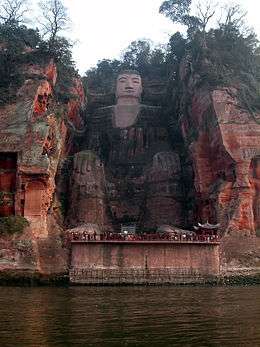 Leshan Giant Buddha | |
| Official name | Leshan Giant Buddha Scenic Area |
| Location | Sichuan, People's Republic of China |
| Part of | Mount Emei Scenic Area, including Leshan Giant Buddha Scenic Area |
| Criteria | Cultural and Natural: (iv)(vi)(x) |
| Reference | 779 |
| Inscription | 1996 (20th Session) |
| Coordinates | 29°32′41″N 103°46′24″E / 29.54472°N 103.77333°ECoordinates: 29°32′41″N 103°46′24″E / 29.54472°N 103.77333°E |
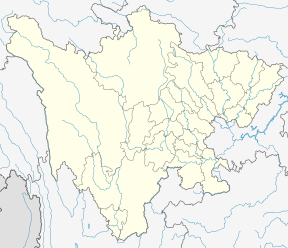 Location of Leshan Giant Buddha in Sichuan 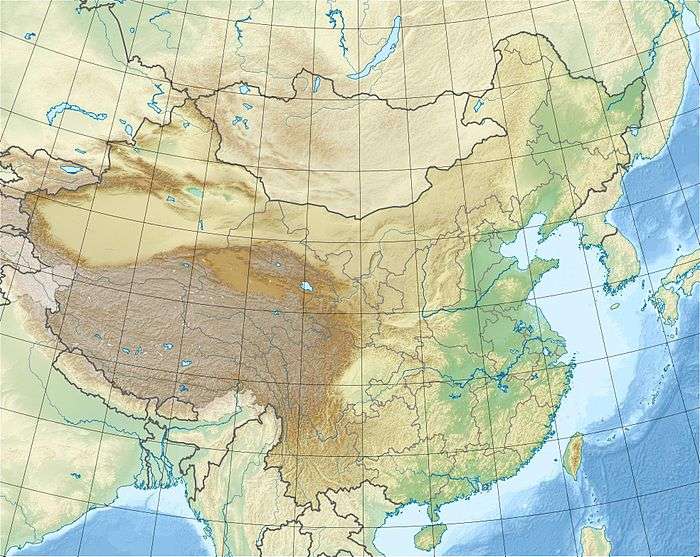 Leshan Giant Buddha (China) | |
The Leshan Giant Buddha (simplified Chinese: 乐山大佛; traditional Chinese: 樂山大佛; pinyin: Lèshān Dàfó) is a 71-metre (233 ft) tall stone statue, built between 713 and 803 (during the Tang Dynasty), depicting Maitreya.[1] It is carved out of a cliff face of Cretaceous red bed sandstones that lies at the confluence of the Min River and Dadu River in the southern part of Sichuan province in China, near the city of Leshan. The stone sculpture faces Mount Emei, with the rivers flowing below its feet. It is the largest and tallest stone Buddha statue in the world[2] and it is by far the tallest pre-modern statue in the world.
The Mount Emei Scenic Area, including Leshan Giant Buddha Scenic Area has been listed as a UNESCO World Heritage Site since 1996.
History
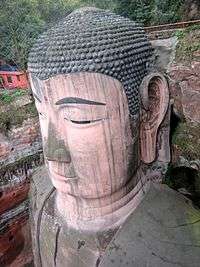
Construction was started in 713, led by a Chinese monk named Hai Tong. He hoped that the Buddha would calm the turbulent waters that plagued the shipping vessels traveling down the river. When funding for the project was threatened, he is said to have gouged out his own eyes to show his piety and sincerity. After his death, however, the construction was stuck due to insufficient funding. About 70 years later, jiedushi Wei Gao decided to sponsor the project and the construction was completed by Hai Tong's disciples in 803.
Apparently the massive construction resulted in so much stone being removed from the cliff face and deposited into the river below that the currents were indeed altered by the statue, making the water safe for passing ships.
A sophisticated drainage system was incorporated into the Leshan Giant Buddha when it was built. It is still in working order. It includes drainage pipes carved into various places on the body, to carry away the water after the rains so as to reduce weathering.
When the Giant Buddha was carved, a huge thirteen story wood structure (similar to the one at the Rongxian Giant Buddha) was built to shelter it from rain and sunshine. This structure was destroyed and sacked by the Mongols during the wars at the end of the Yuan Dynasty. From then on, the stone statue was exposed to the elements.
Degradation
The Leshan Buddha has been affected by the pollution emanating from the unbridled development in the region. According to Xinhua news agency, the Leshan Giant Buddha and many Chinese natural and cultural heritage sites in the region have seen degradations from weathering, air pollution, and swarms of tourists. The government has promised restoration work.[3]
Dimensions
At 71 metres (233 ft) tall, the statue depicts a seated Maitreya Buddha with his hands resting on his knees. His shoulders are 28 metres wide and his smallest toenail is large enough to easily accommodate a seated person. There is a local saying: "The mountain is a Buddha and the Buddha is a mountain". This is partially because the mountain range in which the Leshan Giant Buddha is located is thought to be shaped like a slumbering Buddha when seen from the river, with the Leshan Giant Buddha as its heart.
Gallery
 The cliff to the left of the statue.
The cliff to the left of the statue.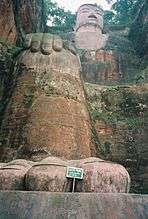 The statue seen from ground level.
The statue seen from ground level. The statue seen from above.
The statue seen from above. The head seen from the staircase.
The head seen from the staircase. path winding up to the statue
path winding up to the statue- Leshan Giant Buddha
See also
References
External links
| Wikimedia Commons has media related to Leshan Giant Buddha. |
